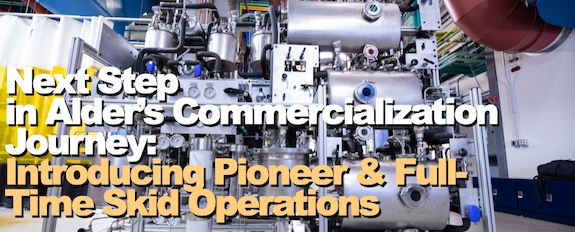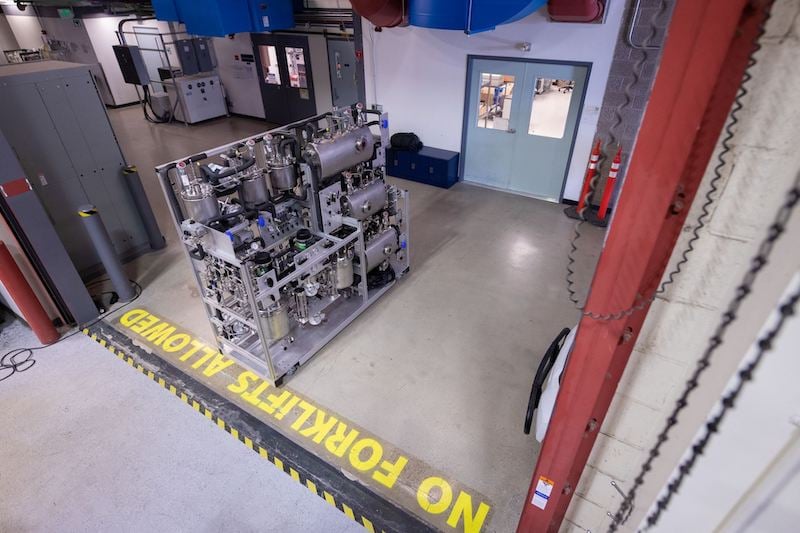Next Step in Alder’s Commercialization Journey: Introducing Pioneer & Full-Time Skid Operations

By Matt Sherick, Pilot Plant Engineer & Dr. Derek Vardon, Chief Technology Officer
Special to The Digest
This week, Alder reached a key milestone in the scale-up of Alder Renewable Crude (ARC) production by commissioning a pilot skid at the National Renewable Energy Laboratory (NREL). Alder’s proprietary technology fractionates fast pyrolysis oil into energy-dense, low-carbon to carbon-negative ARC that can be further transformed into high-value renewable fuels and chemicals using existing commercial-scale refining infrastructure. This skid, which we are calling Pioneer, has been designed and assembled alongside our partners at NREL. Pioneer integrates all unit operations of Alder’s proprietary technology into a continuous process, with a production capacity of one barrel per day of ARC. The skid design and execution were informed by hundreds of bench-scale experiments, continuous pilot and scale-up experiments, and process modeling simulations with NREL and Honeywell UOP.
Why non-hazardous commissioning matters
The first step of commissioning is operating Pioneer with non-hazardous liquid; in this case, water. This step is important because it gives us an opportunity to prove the functionality of all equipment using a non-hazardous fluid. Starting complextesting processes like this one typically comes with unexpected challenges, and it is best practice to troubleshoot andresolve these issues before introducing additional complexities and cost associated with reactive liquids. It also allows us to learn and prepare for “prime time” as we approach fully autonomous ARC production runs, like a commercial refinery. This is an incredibly exciting time for the Alder’s technology team. Many are anxious, including the authors of this post, to press the start button after months of reviewing drawings, acquiring materials, and researching every phase of its development.

Key short-term milestones for Pioneer
Here are some of the key areas we will be focused on over the coming weeks as Pioneer starts operating:
- Pioneer is equipped with design and safety features that are typically found in a commercial facility, including automation hardware and software that allow personnel to operate the unit from a central control room.
- A detailed process hazard analysis was performed during the initial stages of the project, which informed design of automatic control schemes and safety shutdowns that allow Pioneer to run unattended – aside from manual switching of feed and product drums.
- Testing each of these safety features is a key commissioning milestone for the water run, which is expected to be fully completed by mid-May. Commissioning with reactive liquids (e.g., commercial fast pyrolysis oil) will be next.
- After Pioneer is fully commissioned, we intend to operate for extended campaigns (500 hr.+). Our goals for these campaigns include:
- Achieving milestones for integrated continuous operation associated with federally funded grants from the U.S. Department of Energy (DOE) Bioenergy Technologies Office.
- Generating data to refine process conditions with fast pyrolysis oil from a wide range of biomass feedstocks, including Miscanthus grass.
- Miscanthus – produced using regenerative agriculture practices and enabled by a dedicated DOE grant – can catalyze production of carbon-negative fuel.
- Producing hundreds of gallons of ARC to further process into Alder SAF100 for further fuel property testing andfuture flight demonstrations with our partners, like United Airlines and Avfuel.
Partnership & best-in-class technology development
 The bench-scale and pilot development work that Alder executed with NREL and UOP over the last 18-months was heavily influenced by the most rigorous public and private standards of technology development. Pioneer’s creation is the embodiment of what it looks like to undergo best-in-class derisking and development processes in close collaboration with a commercial leader and the national lab ecosystem. We are grateful to both.
The bench-scale and pilot development work that Alder executed with NREL and UOP over the last 18-months was heavily influenced by the most rigorous public and private standards of technology development. Pioneer’s creation is the embodiment of what it looks like to undergo best-in-class derisking and development processes in close collaboration with a commercial leader and the national lab ecosystem. We are grateful to both.
“Getting Pioneer off the ground is a critical milestone for Alder’s business,” said Tim Obitts, Alder’s CEO. “We want to demonstrate commercial optionality for refiners and how Alder Renewable Crude (ARC) is a powerful platform that can unleash a range of renewable products downstream. Pioneer helps us do just that. The beauty of our technology is its adaptability. Once fully commercialized, ARC can be refined into SAF, low-carbon transportation fuels, and renewable chemicals. Many novel technologies that aim to slow the impact of the climate crisis do not make it to this point, so we are grateful to our private and public supporters, including folks at the national labs. Pioneer will demonstrate how decarbonization of challenging sectors can quickly becoming a commercial and technological reality.”
In the case of UOP, Pioneer’s design mimics UOP’s design for commercializing the ARC production process. Specifically, the ARC process design underwent the standard UOP New Product Development process for technology commercialization andinfluenced every step of Pioneer’s creation. The UOP process considers all aspects of the tech-to-market mission, including technical feasibility, engineering scale-up, and deep techno-economic analysis. Stage gate reviews must be completed sequentially at each major phase of development. If the bar for any development phase is not met, the process restarts, so work to meet the requirements to advance can be intense and demands a high degree of rigor and internal review.
“Collaborating with Alder on technology development underlaying Pioneer has been a mutually enriching experience for both NREL and Alder staff,” said Zia Abdullah, NREL’s biomass laboratory program manager. “NREL staff have learned what success means and what performance criteria are critically important for industry and for technology commercialization, and Alder has been able to leverage the unmatched science, technological, and engineering capabilities of a DOE national laboratory. We anticipate smooth commissioning with water, quickly leading to a successful startup with fast pyrolysis oil. This has been an exciting journey with Alder, and we are looking forward to the billions of gallons of SAF that this technology will eventually produce.”
NREL’s role in Pioneer’s development has also been essential. We were particularly grateful to have worked with the NREL Design/Build team, which includes talented engineers, technicians, programmers, and safety experts. Alder’s technical team is still growing, so we needed NREL’s expertise for this first-of-a-kind, fully customized, and integrated pilot plant. TheNREL Design/Build team provided hands-on support at every step of the process, including 3D design support, safety review,part sourcing, control system programming, and finally construction. Pioneer is located within NREL’s Thermal and CatalyticProcess Development Unit and is fully integrated with the national lab’s safety infrastructure.
“Pioneer is the next major step toward making Alder’s technology a commercially viable reality by allowing the team to collect important scale-up data from a commercially relevant continuous process,” said Braden Peterson, NREL’s engineer lead for the project. “NREL’s Design/Build team was critical in bringing Pioneer to fruition through thorough design studies at inception to detailed multidisciplinary engineering analysis, exhaustive process hazard analysis, complete 3D modeling prior to build execution, and finally build execution to ensure the process design was captured and implemented to specification. This pilot process consists of considerable safety implementations for unattended operations and rigorous mass balance closure capabilities to best inform the first commercial scale implementation. The team is extremely excited and proud to be commissioning the process after thousands of hours of planning and preparations.”
As we move into this technology development and commercialization phase, Alder and NREL will employ a joint-staffing model to operate Pioneer, creating the type of knowledge transfer that is imperative in scale-up phase of a new production process such as this one. It is also an advantage that the skid is co-located down the hall from world-class analytical laboratories, staffed with technicians ready to perform detailed sample analysis and provide real-time operational feedback.
Conclusion
Moving renewable production from creation, research, and bench-scale samples to fully integrated pilot-scale production is one of the most important milestones a company like ours can reach. Getting Pioneer up and running has taken amonumental effort from a lot of talented and committed people, and we are very excited (and relieved) to formally take this next step towards commercializing ARC production.
We are also eager to demonstrate what this powerful technology can really do, and the renewable downstream products it can unlock for refiners. This next phase of our journey is arguably the most important one: showcasing the continuous and independent production of Alder Renewable Crude. If you have thoughts, feedback, or ideas you want to share based on this post, please reach out. We would love to hear from you: [email protected]
Category: Fuels















